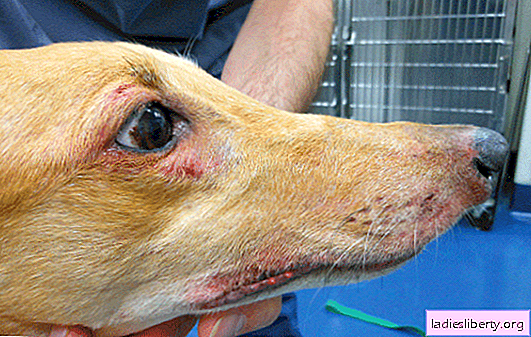
Favorite pets are susceptible to a variety of diseases. Dermatitis is one of the most common skin diseases. There are different types of this ailment with characteristic symptoms, it is necessary to treat inflammation as soon as possible.
Symptoms of dermatitis in dogs
Pathology has its own distinctive symptoms. There are major ones that are common. For example, itching and combing of the skin. And there are symptoms that are characteristic of each type of disease. Dermatitis is an inflammation of the skin that affects all its layers. If the skin ceases to fulfill its main function of protecting the body from various injuries, bacteria and is exposed to diseases, dermatitis can begin.
Common symptoms include the following:
- the temperature in the lesion rises;
- the affected area begins to redden;
- the hairline is disturbed (the dog may begin to bald, as the hair falls out intensively);
- the animal is worried about itching and swelling;
- soreness of the affected area;
- the formation of blood crusts due to capillary bleeding;
- inflammatory process in the tissues of the skin;
- combs become ulcers;
- change in dog behavior. The pet becomes nervous and irritated, there is a decrease in appetite.
If the pathology progresses, and there is no necessary treatment, the dog becomes anxious, sleeps poorly, and the body gradually depletes. The disease causes the pet suffering and is difficult. Therefore, it is very important to contact the veterinarian in time and begin the correct therapy, otherwise the consequences can be dire for the animal. In no case should you self-medicate.
Varieties and causes of the disease
There are several types of dermatitis in dogs, depending on the cause that led to the disease.
Types of dermatitis:
• allergic. This type of inflammatory process is most common. An allergic reaction can occur to pollen, food, medicines, detergents, tick and flea medications. The culprits of the appearance of allergies are many. It is almost impossible to independently identify the cause. The help of a veterinarian is needed, otherwise it will not be possible to cure the pet completely;
• mechanical. It develops as a result of skin trauma and is most easily treated. For example, when a dog presses a collar or a muzzle. If you tighten the tape tightly or cut the pet short, traumatic dermatitis can also occur. The skin is injured, so pathogens easily penetrate inside and cause redness, inflammation and swelling of the dermis;
• medication. This type of dermatitis is formed in response to the action of drugs (iodine, ointment, antiseptics). An animal may have intolerance to some drugs; the consequences can be serious. As a result, allergic dermatitis may develop, itching and peeling are observed;
• contact. It occurs when the skin of the dog is injured in contact with strong irritants (rubbing collar, hot battery, chemicals). It happens that a pet runs on a recently washed wet floor, and later on affected areas appear on the pillows of paws;
• parasitic. This disease is caused by parasites (fleas, ticks, helminths);
• thermal. This type of dermatosis appears under the influence of thermal or radiation exposure. Burns, x-rays, microwaves, or ultraviolet radiation can lead to inflammatory reactions and wounds. The effect of low temperature also leads to the same consequences. For example, frostbite;
• near wounded. Develops near the wound. Pus promotes inflammation of the tissues on the edge of the wound. There is swelling and redness of the affected area, as well as high fever;
• infectious. Various pathogens lead to this type of dermatosis. These are fungi, viruses, bacteria. Staphylococcal dermatitis is the most common.
What causes dermatitis in dogs? There are various factors that influence the development of an ailment. These are seasonality, chronic diseases, a particular microclimate, external temperature, the presence of parasites in the animal, the consequences of drug therapy, endocrine disorders, poor nutrition, poor pet care, and the inflammatory process of internal organs.
How to treat dermatitis
Before starting therapy, you need to correctly establish the cause. The main thing is to contact the veterinarian in time, who will conduct a diagnosis and develop an individual treatment regimen. The impact should be comprehensive. The disease in an advanced stage can lead to serious complications: skin edema, the appearance of bleeding ulcers, hair loss. Self-medication is excluded.
Treatment includes drug therapy and physiotherapy. Only the doctor must decide what can be given to the dog: immunomodulators, antiviral agents, anti-inflammatory drugs, antibiotics, drugs against fungi. If you start the treatment of the disease in a timely manner, the prognosis for recovery is ninety percent positive. It is also necessary to remember and inform the veterinarian if industrial vitamins have been introduced into the dog's diet. Maybe it was they who led to the development of allergic dermatitis.
Before starting treatment, the hair on the affected area needs to be cut. This will facilitate access to the skin. Necrotic tissue is removed with an antiseptic solution and dusted with an antiseptic. Locally used dressings with different ointments that have antifungal and anti-inflammatory, as well as regenerative effects. Vitamin therapy also helps. In addition to drugs, you will need to change the diet, which should be hypoallergenic.
Dog Dermatitis Prevention
It is advisable not to allow the development of dermatitis in your beloved pet, to treat him carefully and regularly take him to a qualified veterinarian for examinations. We need to think about preventive rules.
Prevention measures include:
• balanced diet;
• treatment of any damage with antiseptics;
• proper care and hygiene;
• timely treatment against parasites;
• the right choice of collar and muzzle to minimize mechanical irritation;
• self-medication is excluded;
• regular inspection for irritation;
• proper use of drugs;
• if you have any diseases, consult your veterinarian.
Dermatitis in dogs is a rather unpleasant ailment. Untimely therapy can lead to various complications. When the first symptom appears, you must contact the veterinary center. After all, the health and life of the dog largely depends on proper care and a serious attitude from the owner.











